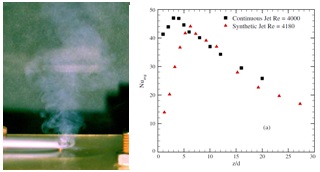
A synthetic jet is formed when the fluid is alternately sucked into and ejected from a small cavity by the motion of a diaphragm bounding the cavity, so that there is no net mass addition to the system (see figure). A synthetic jet is synthesized directly from the fluid in the system in which it is embedded. This feature obviates the need for input piping or complex fluidic packaging and makes synthetic jets ideally suited for low-cost batch fabrication using micro-machining techniques. The synthetic jet is a new entrant into the means available to engineers to manipulate flow to achieve the desired result. Synthetic jet has applications in cooling, boundary-layer separation control, jet vectoring, mixing, creation of local turbulence, etc.

The flow, heat transfer and acoustic characteristics of a synthetic jet, with application to electronic cooling, have been experimentally and numerically investigated. The exit velocity averaged over an excitation cycle indicates a lower and an upper bound on the frequency for the formation of a jet, and shows resonance at two frequencies. Direct impingement heat transfer characteristics of a synthetic jet show that the behaviour of the average Nusselt number is similar to that obtained for a continuous jet. However, Reynolds number dependence of Nusselt number is stronger for synthetic jet as compared to continuous jet. The effect of shape of the orifice – circular, elliptical, square, rectangular, on impingement cooling of a heated surface is also investigated. The effect of inclination angle is also studied. A novel multiple orifice synthetic jet cavity is designed and its performance characterized.The utility of synthetic jet for practical electronics cooling is demonstrated by quantifying the behaviour of the thermal resistance of a heat sink employed along with an impinging synthetic jet, and by measuring the average heat transfer coefficient in a narrow confined enclosure in the form factor of a flow duct that is typical of widely used electronic system. It is shows that synthetic jet can be used for localized cooling of electronic components in the duct (server/router).
Bhapkar, U., Srivastava, A., Agrawal, A.,
"Proper cavity shape can mitigate confinement effect in synthetic jet impingement cooling," Experimental Thermal and Fluid Science, Vol. 68, pp. 392-401, 2015.
Bhapkar, U., Srivastava, A., Agrawal, A.,
"Acoustic and heat transfer characteristics of an impinging elliptical synthetic jet," International Journal of Heat and Mass Transfer, Vol. 79, pp, 12-23, 2014.
Bhapkar, U., Mohanan, S., Srivastava, A., Agrawal, A.,
"Interferometry Based Whole-Field Heat Transfer Measurements of an Impinging Turbulent Synthetic Jet," International Communications in Heat and Mass Transfer, Vol. 58, 118-124, 2014.
Bhapkar, U., Srivastava, A., and Agrawal, A.,
"Acoustic and heat transfer aspects of an inclined impinging synthetic jet," International Journal of Thermal Sciences, Vol. 74, pp. 145-155, 2013.
Chaudhari, M., Puranik, B.P., and Agrawal, A.,
"Heat transfer characteristics of a heat sink in presence of a synthetic jet," IEEE Transactions on Components, Packaging and Manufacturing Technology, Vol. 2, pp. 457-463, 2012.
Chaudhari, M., Puranik, B.P., and Agrawal, A.,
"Multiple orifice synthetic jet for improvement in heat transfer," International Journal of Heat and Mass Transfer, Vol. 54, pp. 2056-2065, 2011.
Jain, M., Puranik, B.P., and Agrawal, A.,
"A numerical investigation of effects of cavity and orifice parameters on the characteristics of a synthetic jet flow," Sensors and Actuators A, Vol. 165, pp. 351-366, 2011.
Chaudhari, M., Puranik, B.P., and Agrawal, A.,
"Heat Transfer Analysis in a Rectangular Duct Without and With Cross-flow and an Impinging Synthetic Jet," IEEE Transactions on Components and Packaging Technologies, Vol. 33, pp. 488-497, 2010.
Chaudhari, M., Puranik, B.P., and Agrawal, A.,
"Effect of orifice shape in synthetic jet based impingement cooling," Experimental Thermal and Fluid Science, Vol. 34, pp. 246-256, 2010.
Chaudhari, M., Puranik, B.P., and Agrawal, A.,
"Heat transfer characteristics of synthetic jet impingement cooling," International Journal of Heat and Mass Transfer Vol. 53, pp. 1057-1069, 2010.
Chaudhari, M., Verma, G., Puranik, B., and Agrawal, A.,
"Frequency response of a synthetic jet cavity," Experimental Thermal and Fluid Science, Vol. 33, pp. 439-448, 2009.
Agrawal, A., and Verma, G.,
"Similarity analysis of planar and axisymmetric turbulent synthetic jets," International Journal of Heat and Mass Transfer, Vol. 51, pp. 6194-6198, 2008.
References